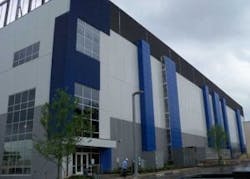The New York/New Jersey data center market is experiencing a strong rebound, as stronger leasing in recent years has gradually absorbed vacant space. The region has recently seen new entrants, as well as growth in a new sub-market in Rockland County, N.Y.
According to research from JJL, continued edge growth and expansion in carrier hotels among carrier, content, and technology tenant base are pushing growth in New York. Meanwhile, New Jersey continues to see steady expansion from financial services, healthcare, and technology, and is likely to be back in building mode soon as larger deals whittle down the available inventory.
Consistent absorption of 20+ megawatts (MEs) over the last three years, has reduced the available supply to about 17 MWs of available capacity. That means it will soon be time to build, according to JLL.
“Financial services have a pipeline for over 20 MW of need in 2022,”the real estate firm said in a recent report. “Cloud network edge nodes continue to emerge and compete with enterprise for market capacity. Leading operators have planned expansions for over 100 MW coming online in 2H 2024.”
Regional Market Overview
New York City is one of the world’s great business hubs, home to Wall Street and a vibrant regional economy. Technology plays a critical role in the operations of the financial sector and the larger NYC business community, making the Greater New York region one of the nation’s major markets for data center space.
In recent years, the Greater New York data center market has faced several strong headwinds, including the financial crisis and its chilling effect on spending, and fallout from flood-related outages during Superstorm Sandy. These events, along with the segmentation of the market along geography and business models, have made Greater New York a challenging market for service providers.
A technician works inside the Digital Realty data center inside 60 Hudson Street in New York City, a key aggregation point for global data traffic. (Photo: Digital Realty)
Many data center companies see an opportunity in New York and New Jersey, which boasts a critical mass of marquee enterprise customers. Looking to the future, there is the potential for new technologies to boost the data center business in the region’s population centers.
Notably, Manhattan has seen a revitalization at 60 Hudson Street, the iconic carrier hotel, where Hudson Interxchange has rebranded and expanded, while NYI has expanded with a deal to take over space formerly occupied by Equinix.
New York and New Jersey are contiguous markets, and some data center customers consider the entire region in making decisions about where to deploy data center space for their IT infrastructure. But each state has unique characteristics in data center inventory, the price of electricity, and incentives and economic development.
According to a 2021 JJL report, continued edge growth and expansion in carrier hotels among carrier, content, and technology tenant base are pushing growth in New York.
A recent JLL report found 1.02 million square feet of data center space in New York, or about 152 MWs of capacity. About 62,000 SF is vacant, with about 2.5 MWs of net absorption in the first half of 2022. .
A Digital Realty data center in Clifton, New Jersey. The company has begun a new campus in nearby Totowa. (Photo: Rich Miller)
New Jersey continues to see steady expansion from financial services, healthcare, and technology to start 2021, as well. Total inventory is sitting at 3.85 million and 410 MW as of mid-2022. Vacancies are holding at 120,000 square feet and 17 MW.
New York
America’s largest city is a top market for data centers. While New York City’s high cost of doing business often deters providers, some companies require a data center located in the city. Almost all data centers in the New York City market are concentrated in Manhattan, with the majority of providers in retrofitted high-rise towers.
Despite Hurricane Sandy and the turbulence in the financial sector, having data center space in Manhattan remains essential for many blue-chip companies and service providers.
Data center demand in New York is dominated by the presence of the financial industry, which employs 330,000 in New York and accounts for more than 39% of the city’s economic output. Many large financial IT firms became more amendable to working with service providers and operating in data centers controlled by third-parties.
Manhattan also has a high concentration of technology firms and startups (“Silicon Alley”), while the insurance, real estate and healthcare industries also drive demand for data center space.
Manhattan has a reputation as a mature data center market, with most of its space focused in a handful of connectivity hubs that were established in the late 1990s following the deregulation of the telecom industry. The city’s most prominent “carrier hotels” built upon established intersections for commerce and communications. That includes the AT&T building at 32 Avenue of the Americas, and the former Port Authority building at 111 8th Avenue, which is now owned by Google.
Google’s purchase of 111 8th Avenue altered the competitive landscape, as the company wanted to use the building’s large footprints for office space, not colocation. Around that same time, the New York City Department of Corrections was vacating four floors of office space that it leased at 60 Hudson Street.
There are two meaningful developments in the Manhattan market in early 2022, both at 60Hudson Street:
- Hudson Interxchange (Hudson IX) is the successor to DataGryd, which was acquired by UK investor Cordiant Digital Infrastructure. The revamped Hudson IX has a new brand, and will expand its footprint inside 60 Hudson Street, one of the world’s most iconic carrier hotels.
- NYI is expanding its operations at 60 Hudson Street in New York into space formerly occupied by Equinix. NYI is expanding via a joint venture with QTD Systems, which acquired the facility from Equinix and plans to use part of the space to research quantum computing technology.
Sabey recently added supply to support existing tenant expansion needs. Digital Realty and Coresite compete for cloud service business at 32 Avenue of the Americas. 1547 and Datagryd position shell conversion space. And 325 Hudson continues to attract near carrier hotel traffic and Teirpoint, Webair, and NYI compete for managed services.
While several data center providers are active in the New York market, most operators prefer to invest on large scale deployments in markets with lower costs. Although the density of businesses in the New York metropolitan area creates enough demand to occupy a large facility, the power costs alone can prevent data center providers from investing in the area.
This has prompted the emergence of a new data center sub-market in Rockland County, focused on the town of Orangeburg, about 25 miles north of Manhattan. In 2021 DataBank announced a major expansion in Orangeburg, buying a 34-acre property where it plans to build a 200,000 SF, 30 MW data center. In May 2022, ColoHouse expanded its footprint in the 1547 Critical Systems Realty facility in Orangeburg, adding 15,000 SF of capacity.
New Jersey
It’s no surprise the New Jersey data center market has grown over the past few years. Overcoming the threat of oversupply just a few years ago, the market has continued to see demand and activity from data center users and operators.
The majority of data center activity in the New Jersey market can be seen in two areas: The I-95 Corridor in Northern New Jersey and in Central New Jersey along Route I-287 (approximately 30 miles to the southwest). A cable landing station in Wall Township has become a destination for subsea data traffic from Europe and South America, and offers a more affordable route into the Northeast than sites in NYC.
The Northern New Jersey colocation market has grown considerably over the last few years due to proximity to New York City, robust infrastructure and favorable business climate.
A corridor in a Cologix data center in New Jersey. (Photo: Cologix)
The majority of data center activity in the New Jersey market can be seen in two areas: The I-95 Corridor in Northern New Jersey and in Central New Jersey along Route I-287 (approximately 30 miles to the southwest). The Northern NJ market on the I-95 Corridor includes the following cities: Weehawken, Jersey City, Carlstadt, Secaucus, Clifton, and Newark.
The New Jersey market is made up of mostly larger colocation and single-tenant data center users. Typical requirements in the Northern New Jersey market are above 1 MW, but some companies entering the market will have requirements starting at 100 kW.
Demand continues to increase in New Jersey among financial services, life sciences, and technology sectors. Increased demand for managed services, including IaaS, bare metal, disaster recovery and cybersecurity, accelerates as result of hybrid cloud deployments.
Service providers have been among those filling data center space in New Jersey.
The potential of a financial transaction tax has financial markets, buy and sell side players, and trading firms on alert. Several operators are looking for anchor tenant opportunities to add this market to their portfolios. Operators and tenants are poised for a healthy recovery, according to JLL.
For users, latency performance is driving new product innovation, and investments are being made in IoT sensors for operational efficiency.
Providers are looking for sites with available power in high demand. And industrial developers contending for prime locations in Northern New Jersey. Sale lease-backs and subleases emerging in older facilities in 2021.
Business Environment
Many factors are considered in the site selection process for IT infrastructure. Here’s a look at some of these issues and how they vary between New York and New Jersey:
CONNECTIVITY
Over two dozen fiber carriers offer connectivity in New York City. Nationally-known carriers such as CenturyLink, Level3, Sprint, Verizon, XO, and Zayo offer a mix of both metro and long haul fiber. Regional and specialized providers such as Axiom, Fibertech, and Lightower serve Manhattan’s data center clusters with high-quality fiber. NYC also serves as a network interconnection point at the eastern edge of the United States to the transatlantic undersea Internet cables running between North America and Europe.
POWER
NYC’s transmission lines and substations in Manhattan provide stable power on a robust but aging grid. Consolidated Edison Company of New York (ConEd) is the investor-owned and state-regulated utility providing electricity to NYC. ConEd’s rates are extremely high, and political initiatives have done little to either maintain or lower these rates.
DISASTER RISK
The New York City market is at relatively low risk for natural disasters such as hurricanes and earthquakes. Superstorm Sandy caused extensive flooding and wind damage, but is something of a historic outlier due to an unusual path that steered the storm on a Western path into New Jersey, rather than following prevailing currents and winds that steer storms out to sea or towards Long Island.
ECONOMIC DEVELOPMENT AND INCENTIVES
New York City does not offer formal tax abatement and incentives for data centers. However, large data center providers and enterprises wanting to build new or retrofit an existing building can lobby NYC officials to ease the sales and use taxes in some cases.
Top players/provider list
- 1547 REALTY GROUP
- 365 DATA CENTERS
- AT&T
- CORESITE
- CYRUSONE
- DATABANK
- DIGITAL REALTY
- EQUINIX
- HUDSON INTERXCHANGE
- INTERNAP
- IRON MOUNTAIN
- LUNAVI
- IRON MOUNTAIN
- NETRALITY PROPERTIES
- NJFX
- QTS REALTY TRUST
- SUNGARD AVAILABILITY SERVICES
- T5 DATA CENTERS
- TELEHOUSE AMERICA
For more on the New York/New Jersey data center market, we invite you to download the “Data Center Frontier Special Report: The New York/New Jersey Data Center Market,” sponsored by Digital Realty.





